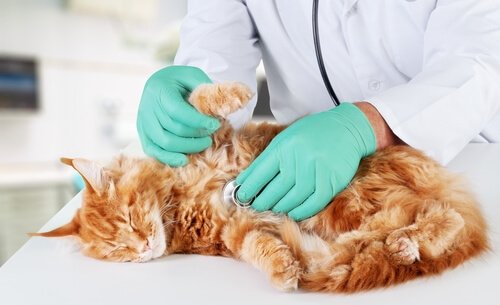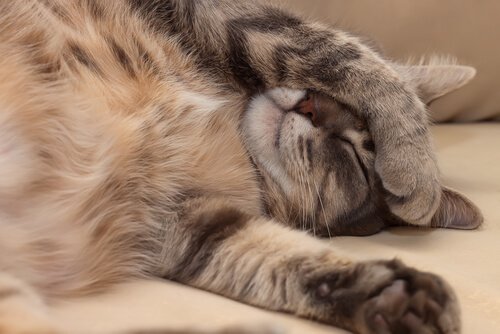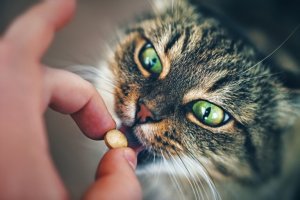Treatment and Care for Hypertrophic Cardiomyopathy in Cats

Its name is somewhat difficult to pronounce, but the fact is that hypertrophic cardiomyopathy in cats is one of the most common heart diseases in domestic felines. In this article, we’ll tell you everything you need to know about it.
What is hypertrophic cardiomyopathy in cats?
This heart disease is one of the most common ones in felines. Hypertrophic cardiomyopathy is the thickening of the myocardial mass of the heart’s right ventricle. The main causes of hypertrophic cardiomyopathy are not yet known. However, scientists do know that the cats who suffer from it have elevated levels of growth hormones. In some cases, it is hereditary.
At the same time, it is more prevalent in certain breeds, like Persian, Chartreux, Sphynx, British Shorthair, Ragdoll, and Maine Coon Cats. Therefore, scientists believe that genetic malformations may be the cause of it.
Feline hypertrophic cardiomyopathy is characterized by diastolic dysfunction. It is more common in males than in females. In addition, young cats between five months and six years old often have this disease.
Hypertrophic cardiomyopathy can occur in three levels: mild, moderate, or severe. The latter increases the stiffness of the heart’s left ventricle, and may compromise blood flow to the myocardium. This can lead to cell death, or fibrosis.

Many cats with hypertrophic cardiomyopathy have no visible symptoms. This is why veterinarians often don’t detect the disease early. A veterinarian can identify breathing difficulties, a systolic murmur, tachycardia, arrhythmias, dyspnea, or even paralysis in the posterior limbs.
However, since all these symptoms are also typical of other common heart diseases, sometimes professionals don’t know what their cause is. Therefore, they don’t diagnose feline hypertrophic cardiomyopathy right away.
The best way to detect it is through specific tests, such as electrocardiograms and cardiac ultrasounds. With the first test, a specialist can detect abnormal heartbeats. With the second test, they can detect any increase in ventricular thickness, dilation of the left atrium, or a decrease in “light” in the left ventricle.
Treatment of the condition
Once he has diagnosed a cat with this disease, a veterinarian will be responsible for prescribing the best treatment for it. The objective of the treatment will be to improve diastolic performance, prevent the onset of a thromboembolism, or treat congestive heart failure.
In addition, treatment will depend on a number of factors, such as age, and the animal’s overall health. Keep in mind that feline heart disease has no cure. However, you can help your pet live with the disease in the best possible way.

The most common medications used in this case are:
- Angiotensin-converting enzyme inhibitors (ACEI) to reduce cardiac burden
- Diuretics to reduce the accumulation of fluids in the pleural cavity and in the lungs
- Beta-blockers to lower the heart rate when tachycardia occurs
- Acetylsalicylic acid to prevent thromboembolism
- Calcium channel blocking to relax the heart muscle
Care for hypertrophic cardiomyopathy in cats
As for care, you must make sure that your cat is eating food with low salt content. There is special food for this. It will prevent liquid retention, which could make things worse.
You should reduce stress or tensions at home as much as possible, so that the animal is calm and gets enough rest, and is never frightened.
The cat should not undergo physical activity or stress when suffering from hypertrophic cardiomyopathy. However, some playing and short walks around the house are necessary.
Obviously, the key is to follow your veterinarian’s instructions perfectly. You should take your cat to the vet, and get all the tests done that the vet considers necessary.
Hypertrophic cardiomyopathy in cats is quite common, although we don’t know very much about it. However, early detection and compliance with treatment can improve the health of a cat with this disease.
All cited sources were thoroughly reviewed by our team to ensure their quality, reliability, currency, and validity. The bibliography of this article was considered reliable and of academic or scientific accuracy.
Silva, A. C., Muzzi, R. A. L., Oberlender, G., Nogueira, R. B., & Muzzi, L. A. L. (2013). Feline hypertrophic cardiomyopathy: An echocardiographic approach. Archivos de Medicina Veterinaria. https://doi.org/10.4067/S0301-732X2013000100002